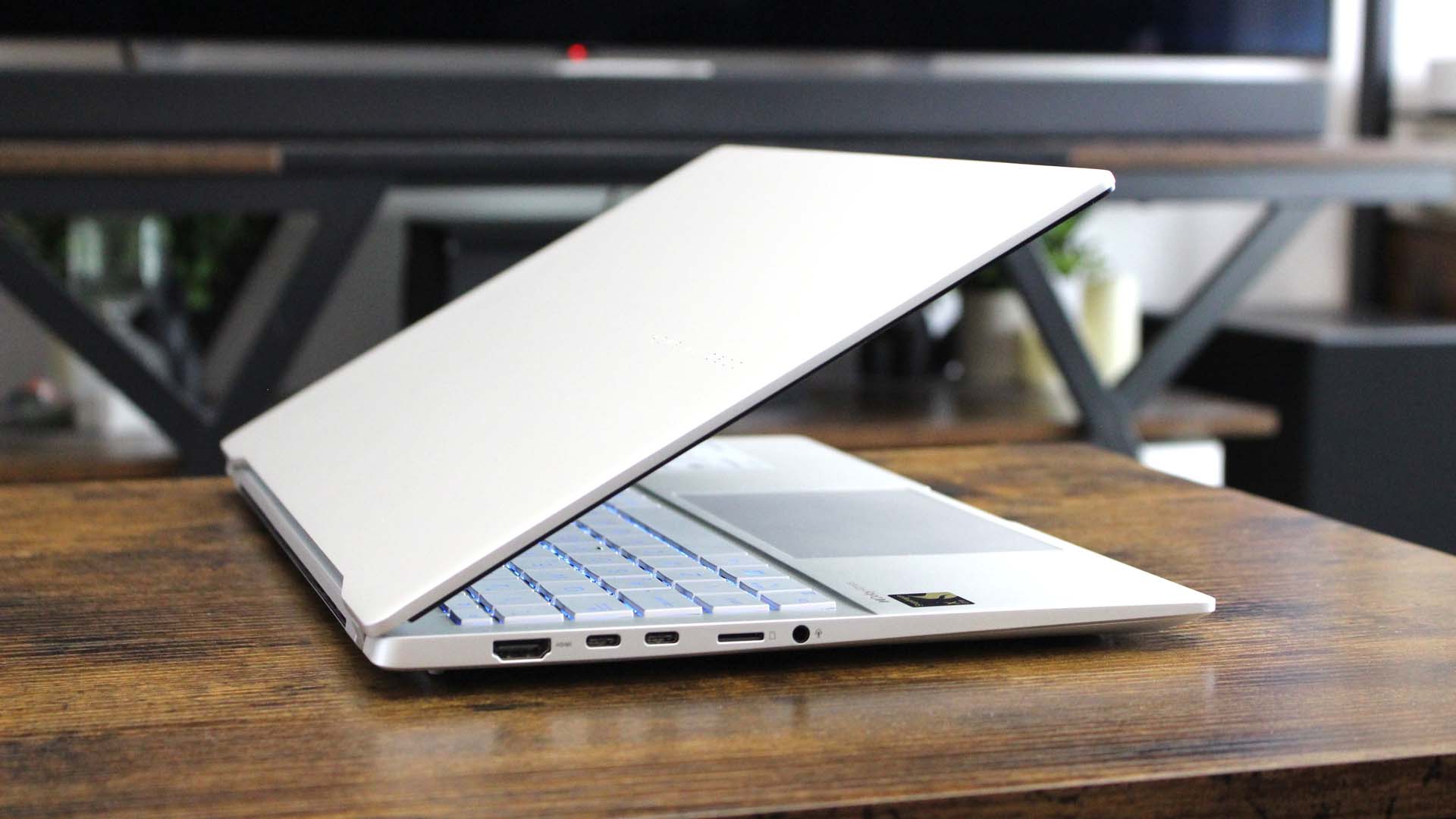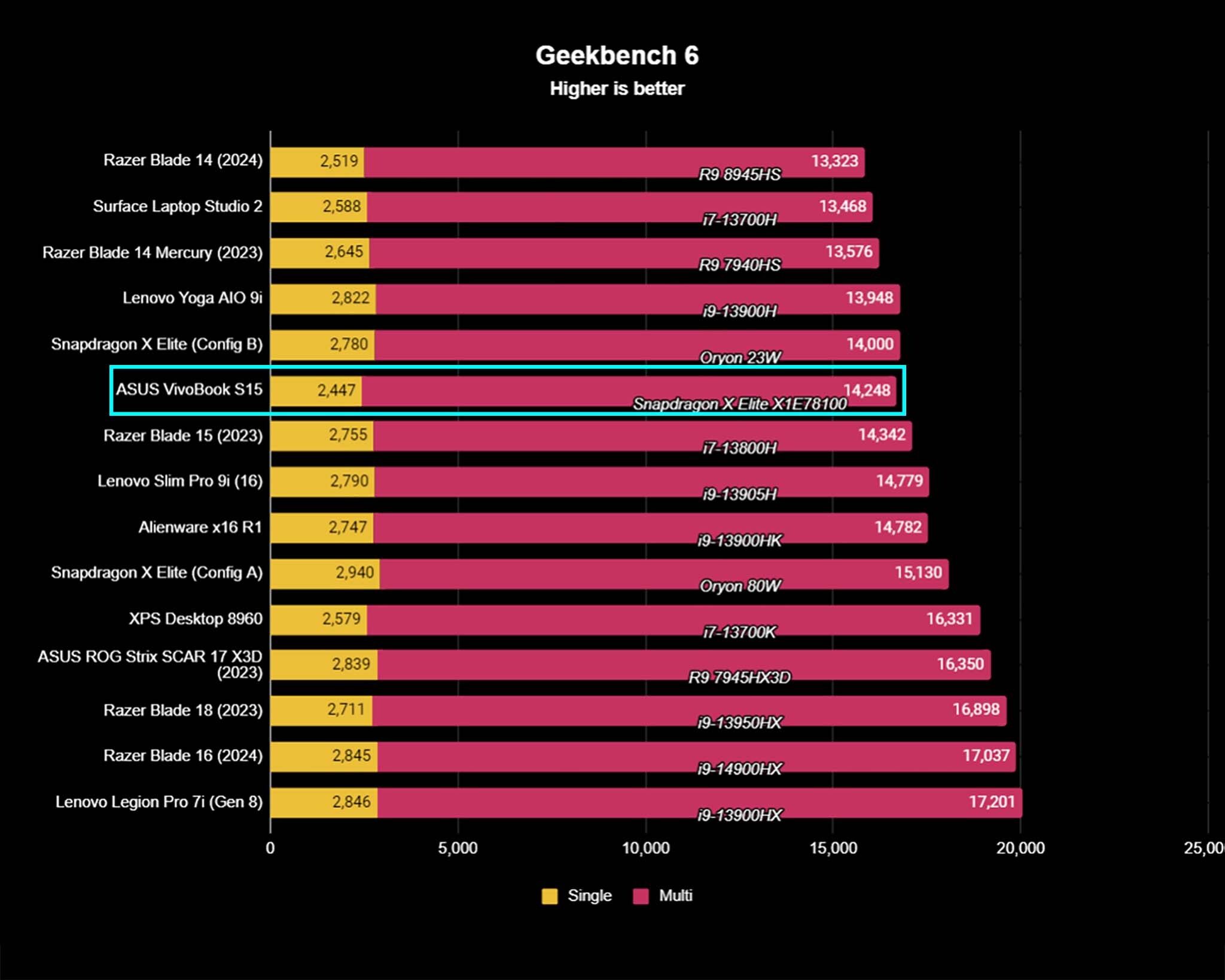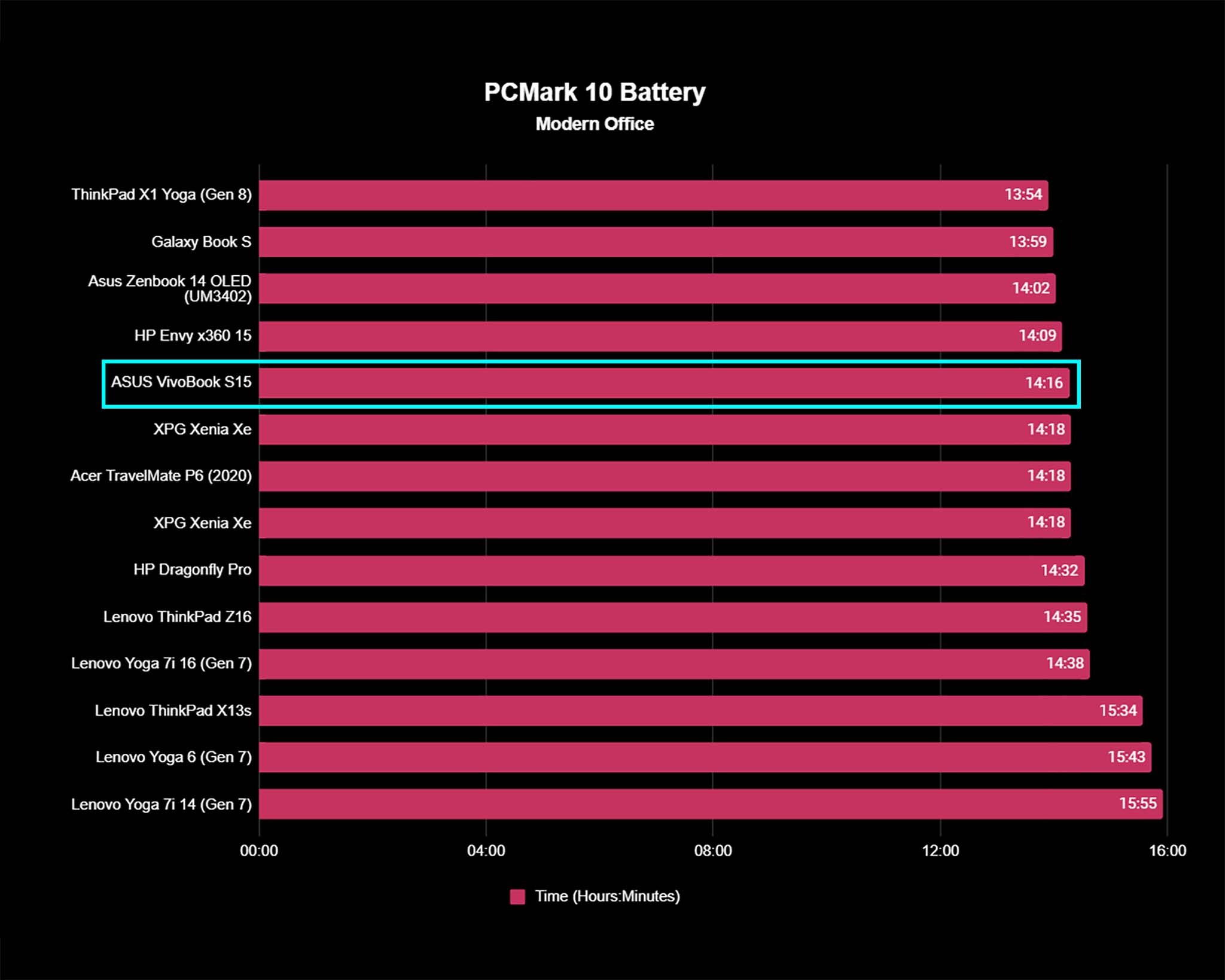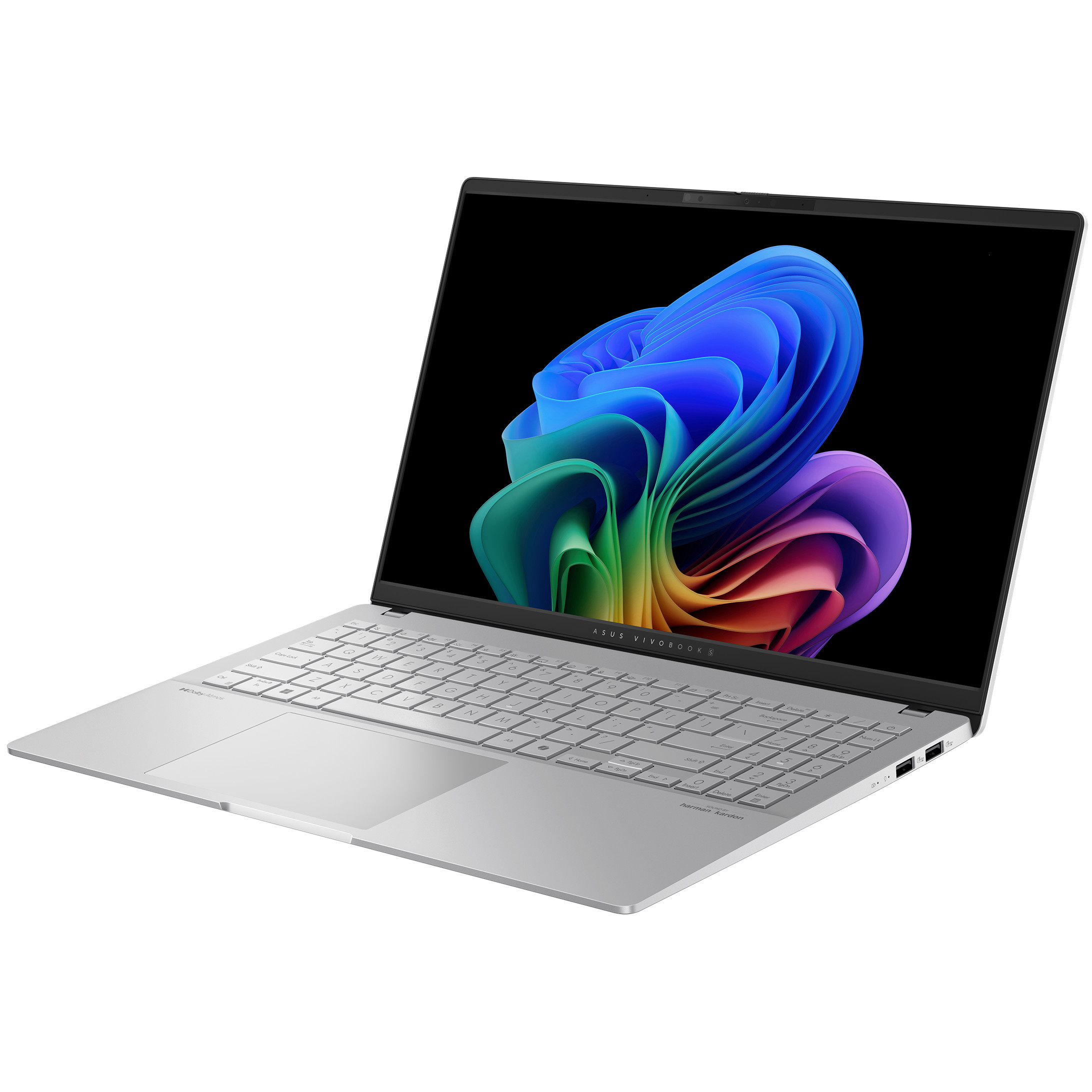
The Vivobook S 15 (S5507) is all-around a better value compared to the Galaxy Book4 Edge, though its speaker setup isn't as impressive and you might not want a 16:9 aspect ratio. It's otherwise a well-rounded Copilot+ PC with strong Snapdragon X Elite performance at a 45W TDP.
Pros
- Generous port selection
- X Elite runs at 45W
- 1080p + IR camera with privacy shutter
- High-res OLED display
- 1.5mm key travel, number pad
- Generally more affordable
Cons
- Fewer speakers
- 16:9 aspect ratio
- Thicker than the Book4 Edge models
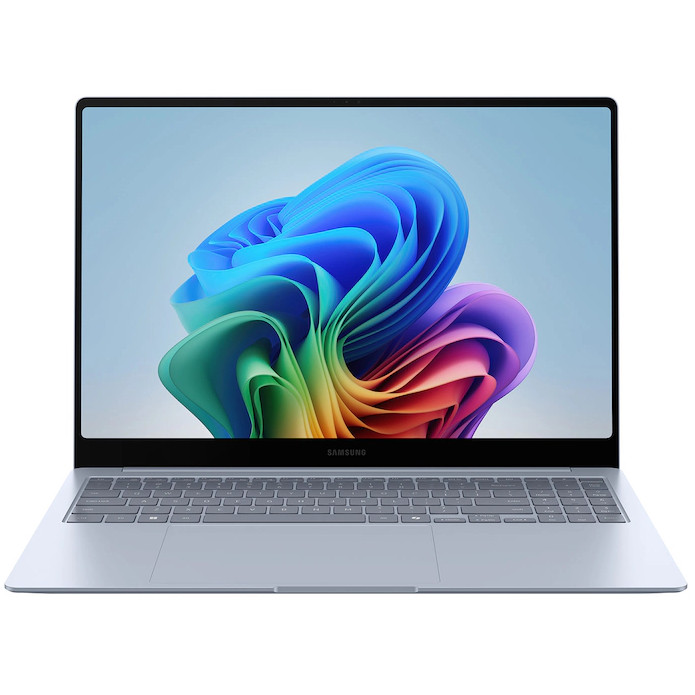
The Galaxy Book4 Edge generally costs more than the Vivobook S 15, but its higher-tier X Elite chips, quad-speaker setup, and 16:10 AMOLED displays will no doubt be worth the extra money to plenty of users. Galaxy AI is a nice bonus for anyone with a Galaxy phone.
Pros
- Quad-speaker setup with Dolby Atmos
- Comfy keyboards, huge touchpads, 16-inch numpad
- Gorgeous high-res AMOLED displays
- Up to a Snapdragon X Elite (X1E-84-100)
- Galaxy AI is a nice bonus
Cons
- Generally more expensive
- No IR sensor or privacy shutter
- Smaller battery capacities
Samsung's Galaxy Book4 Edge and the ASUS Vivobook S 15 (S5507) are two of the world's first Copilot+ PCs to enter the market, and they each bring enough power to run advanced Windows 11 AI features locally.
Beyond the AI aspect, Samsung and ASUS have served up some gorgeous Windows laptops with strong performance and efficiency thanks to Qualcomm Snapdragon X Systems-on-Chip (SoC), OLED displays, and plenty of high-end features.
Samsung's Galaxy Book4 Edge comes in 14- and 16-inch sizes, while the Vivobook S 15 has a more traditional 15.6-inch setup. There are plenty of similarities between the laptops, but there are also some key differences that you should be aware of before making a final decision. Let's take a close look at these laptops to help you make the right decision.
June 18, 2024: I've updated this comparison with new information about the ASUS Vivobook S 15 (S5507) following Senior Editor Zac Bowden's review. — Cale Hunt
ASUS Vivobook S15 vs. Samsung Galaxy Book4 Edge: Specs
It's worth taking a closer look at the raw specifications that make up the ASUS Vivobook S 15 (S5507) and Samsung Galaxy Book4 Edge laptops before we get into a more detailed breakdown.
| Header Cell - Column 0 | ASUS Vivobook S 15 (S5507) | Samsung Galaxy Book4 Edge |
|---|---|---|
| CPU | Snapdragon X Elite (X1E-78-100), Snapdragon X Plus (X1P-64-100) | (14-inch) Snapdragon X Elite (X1E-80-100) |
| Row 1 - Cell 0 | Row 1 - Cell 1 | (16-inch) Snapdragon X Elite (X1E-80-100 or X1E-84-100) |
| RAM | 16GB, 32GB LPDDR5x | 16GB LPDDR5x |
| GPU | Qualcomm Adreno | Qualcomm Adreno |
| NPU | Qualcomm Hexagon (45 TOPS) | Qualcomm Hexagon (45 TOPS) |
| Storage | 512, 1TB M.2 PCIe 4.0 NVMe SSD | 512GB, 1TB (16-inch only) |
| Camera | 1080p + IR, privacy shutter | 1080p |
| Speakers | Two harman/kardon speakers, Dolby Atmos | Four speakers, Dolby Atmos |
| Display | 15.6 inches, 2880x1620, 16:9 aspect ratio, OLED, 120Hz, VESA DisplayHDR True Black 600, glossy, 600 nits peak (HDR), 100% DCI-P3 | 14 inches, 2880x1800, 16:10 aspect ratio, AMOLED, 120Hz VRR, 120% DCI-P3, touch, 400 nits (500 nits HDR) |
| Row 9 - Cell 0 | Row 9 - Cell 1 | 16 inches, 2880x1800, 16:10 aspect ratio, AMOLED, 120Hz VRR, 120% DCI-P3, 400 nits (500 nits HDR) |
| Ports | Two USB4, two USB-A 3.2 (Gen 1), HDMI 2.1, 3.5mm audio, microSD card reader | (14-inch) Two USB4, HDMI 2.1, 3.5mm audio |
| Row 11 - Cell 0 | Row 11 - Cell 1 | (16-inch) Two USB4, USB-A 3.2, HDMI 2.1, microSD card reader, 3.5mm audio |
| Wireless | Wi-Fi 7, Bluetooth 5.4 | Wi-Fi 7, Bluetooth 5.3 |
| Battery | 70Wh | 55.9Wh (14-inch), 61.8Wh (16-inch) |
| Dimensions | 13.88 x 8.93 x 0.58-0.63 inches (352.6mm x 226.9mm x 14.7-15.9mm) | 12.30 x 8.81 x 0.43 inches (312.4mm x 223.7mm x 10.9mm) |
| Row 15 - Cell 0 | Row 15 - Cell 1 | 13.99 x 9.86 x 0.48 inches (355.3mm x 250.4mm x 12.19mm) |
| Weight | 3.13 pounds (1.42kg) | 2.6 pounds (1.18kg) |
| Row 17 - Cell 0 | Row 17 - Cell 1 | 3.4 pounds (1.54kg) |
| Price | From $1,300 | From $1,350 |
ASUS Vivobook S 15 vs. Samsung Galaxy Book4 Edge: Price and availability
The Vivobook S 15 (S5507) and Galaxy Book4 Edge have launched and are readily available to buy.
The best places to pick up the Book4 Edge are either Best Buy or direct from Samsung. Prices start at $1,350 for the 14-inch model and about $1,750 for the 16-inch model.
If you'd rather shop at Samsung, you can get some trade-in credit with valid hardware. Samsung offers up to $500 off depending on the device you trade in, which can lower the starting price to well below $1,000.
The Vivobook S 15 is available to buy from the official ASUS website as well as third-party retailer B&H. You can expect to pay about $1,300 for a model with a Snapdragon X Elite chip, 16GB of RAM, and 1TB SSD.
ASUS Vivobook S 15 vs. Samsung Galaxy Book4 Edge: Design and features
Samsung offers two sizes for its Galaxy Book4 Edge, while the Vivobook S 15 is a nice middle ground at 15.6 inches. All laptops have a sleek all-metal design, with the Book4 Edge models offering the thinnest dimensions. Samsung has a Sapphire Blue color for its Book4 models, while the Vivobook S 15 comes in a more traditional Cool Silver finish. None of these laptops have 360-degree hinges for convertible functionality; instead, they focus on a premium notebook approach.
The Vivobook S 15's keyboard is impressive, serving up customizable RGB lighting and a full number pad for productivity masters. It even has 1.5mm key travel for a comfortable approach. Samsung also added a number pad to its 16-inch Book4 Edge model, while the 14-inch model drops the extra keys. Quality laptops with number pads are popular, so this might be a feature with a lot of weight. Both laptops have sizable touchpads. Typing will ultimately come down to personal preference, but you should expect a high-end experience from any of these devices.
Samsung and ASUS approach biometric security a bit differently. Both lean into Windows Hello, but the Book4 Edge sticks with a fingerprint reader, while the Vivobook S 15 has an IR sensor for facial recognition. All laptops have a 1080p webcam above the display, but only the Vivobook adds a privacy shutter.
The Galaxy Book4 Edge models have an impressive quad-speaker setup. While we haven't yet tested the audio quality, you get output at 13.4W on the 14-inch model and 14W on the 16-inch model. The dual harman/kardon speakers in the Vivobook are just average, so expect Samsung to offer a better listening experience. Dolby Atmos is included across all laptops for further tuning.
Looking at ports, those who need broad native connectivity without a great Thunderbolt dock should stick with the larger models. The 16-inch Book4 Edge has dual USB4, USB-A 3.2, HDMI 2.1, 3.5mm audio, and a microSD card reader for removable storage. The Vivobook S 15 has the same setup, except it adds a second USB-A port to the mix. The 14-inch Book4 Edge is limited to dual USB4, HDMI 2.1, and a 3.5mm audio jack. Wi-Fi 7 and modern Bluetooth are available across all models.
ASUS Vivobook S 15 vs. Samsung Galaxy Book4 Edge: Display
The displays in these laptops are all impressive, and your choice will likely come down to size and aspect ratio. ASUS decided to keep a 16:9 aspect ratio for its 15.6-inch display, resulting in a 2880x1620 resolution. Most non-gaming laptops have moved on to a taller 16:10 or even 3:2 aspect ratio, providing more vertical space. If you're used to 16:10, it might be tough to go back to 16:9.
In any case, ASUS delivers an OLED panel with a smooth and dynamic 120Hz refresh rate, VESA DisplayHDR True Black 600 certification (up to 600 nits with HDR enabled), and 100% DCI-P3 color reproduction. It should be a stellar option for general computing and for photo or video editing thanks to the deep OLED color and contrast.
Samsung's 14- and 16-inch displays have a taller 16:10 aspect ratio with a 2880x1800 resolution. You get more pixel density on the smaller display, but even the 16-inch model will be plenty crisp. Both displays have Samsung's stellar AMOLED panel for unreal color and contrast, and they both have a 120Hz variable refresh rate to be easier on the eyes. Samsung lists 120% DCI-P3 color coverage, as well as up to 500 nits brightness with HDR enabled.
ASUS Vivobook S 15 vs. Samsung Galaxy Book4 Edge: Performance and battery
Qualcomm's Snapdragon X chips power the first wave of Copilot+ PCs to enter the market, bringing strong performance and efficiency for Windows on ARM. These chips have a Neural Processing Unit (NPU) with 45 TOPS of power for local AI acceleration, which is more than the 40 TOPS benchmark set by Microsoft for advanced AI features coming to Windows 11.
The initial Vivobook S 15 model has a Snapdragon X Elite (X1E-78-100) SoC running at 45W, and it's expected that ASUS will also eventually release a model using the more affordable Snapdragon X Plus chip.
The Galaxy Book4 Edge offers the higher-tier X Elite (X1E-80-100 and X1E-84-100) chips, though it's unclear at what TDP they run. Because ASUS has set its chip at 45W, it could end up running faster than the ones in the Book4 Edge. We'll know more when we get our hands on these laptops for testing.
ASUS lists up to 32GB of LPDDR5x RAM, though the initial offering has 16GB. Samsung only lists 16GB across its laptops, though that could change in the future. The Vivobook S 15 comes with a 1TB M.2 PCIe 4.0 NVMe SSD. On Samsung's side, a 1TB SSD is only available in the 16-inch model. The 14-inch model tops out at 512GB.
We've now tested first-hand the Snapdragon X Elite (X1E-78) chip in the ASUS laptop, and the results are impressive. In our Vivobook S 15 (S5507) review, Windows Central Senior Editor Zac Bowden said:
"This chip is a beast, outputting incredible performance that you can feel in almost every task. Whether browsing the web with lots of tabs, multitasking through lots of open apps, rendering video and audio, hosting a podcast, or even some gaming, The Snapdragon X Elite can do it all."
The X Elite "trades blows with the Apple M3," according to Bowden, and it even bests plenty of modern Intel and AMD chips.
As for battery life, Bowden discovered that the 70Wh battery in the Vivobook could go for a full workday and into the next day without needing a charge. It hit more than 14 hours in PCMark 10's Applications rundown, and keep in mind that it's with a high-res OLED display.
The Vivobook S 15 has a larger 70Wh battery compared to 55.9Wh and 618Wh in the Book4 Edge models, but chip TDP and other factors will play a role. Samsung says its 16-inch model can run for up to 22 hours. We'll know more when we get our hands on the Samsung laptops.
ASUS Vivobook S 15 vs. Samsung Galaxy Book4 Edge: Copilot+ and Galaxy AI
Microsoft and Qualcomm teamed up to deliver Copilot+, the next step in AI PCs. Copilot+ is an umbrella term for advanced AI features baked into Windows 11, as well as laptops with an NPU powerful enough to run them locally. So far, that's only laptops with a Snapdragon X chip, but we now know that AMD's Ryzen AI 300 chips and Intel's "Lunar Lake" CPUs will also have an NPU capable of handling Copilot+.
The Galaxy Book4 Edge and Vivobook S 15 both get access to Copilot+, which includes features like Windows Recall, Live Captions, local AI image and text creation, Auto Super Resolution, and advanced Windows Studio Effects.
Samsung's Galaxy AI is an exclusive feature that should appeal to anyone with a Galaxy phone. You can connect your PC and phone to access extra AI features on the larger screen, and Copilot voice commands will even be sent back to your phone for things like messages and reminders.
ASUS Vivobook S 15 vs. Samsung Galaxy Book4 Edge: Which should you buy?
ASUS and Samsung's laptops are quite closely matched, and making a final decision might not be easy if you're looking for a sleek Copilot+ PC. In general, those who value audio quality or who already have a Galaxy phone should lean toward Samsung's laptops. The quad-speaker setup, paired with high-res AMOLED displays, should be great for anyone who watches TV and movies on their laptop.
On the other hand, the Vivobook S 15 also has an OLED display with a crisp resolution and 120Hz refresh rate. It's also a great laptop if you want a bright screen, as ASUS lists it at up to 600 nits with HDR enabled. The drawback is a 16:9 aspect ratio, which doesn't provide as much vertical screen space. If you want an IR sensor and a privacy shutter for the webcam, ASUS is also the way to go.
We now have a clear idea of how strong and efficient the X Elite chip can be, but we'll have to test the Samsung Galaxy Book4 Edge directly for a clear comparison. In any case, you should be safe in assuming that Snapdragon X is the real deal no matter the laptop.
Finally, pricing will play a big role in your final decision. The Vivobook S 15 with a Snapdragon X Elite chip, 16GB of RAM, and 1TB SSD costs about $1,300. The smaller Book4 Edge with 16GB of RAM and 512GB SSD costs about $50 more. And if you want the larger 16-inch Book4 Edge, prices start at $1,750 for 16GB of RAM and a 1TB SSD. If you're looking for the best value possible, ASUS has Samsung beat.
All the latest news, reviews, and guides for Windows and Xbox diehards.

Cale Hunt brings to Windows Central more than nine years of experience writing about laptops, PCs, accessories, games, and beyond. If it runs Windows or in some way complements the hardware, there’s a good chance he knows about it, has written about it, or is already busy testing it.

